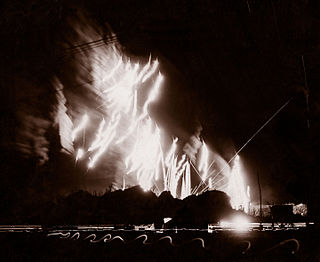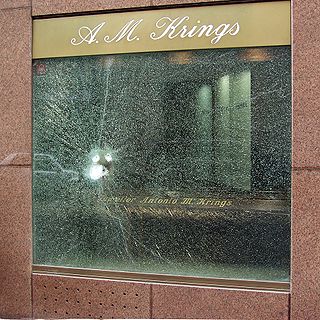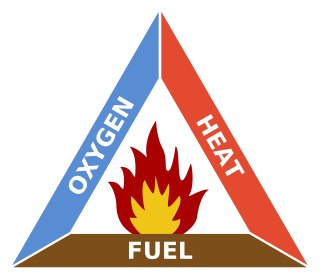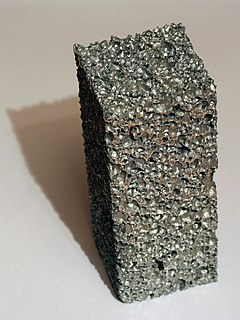Related Research Articles

A bullet is a kinetic projectile, a component of firearm ammunition that is shot from a gun barrel. The term is from Middle French, originating as the diminutive of the word boulle (boullet), which means "small ball". Bullets are made of a variety of materials, such as copper, lead, steel, polymer, rubber and even wax. Bullets are made in various shapes and constructions, including specialized functions such as hunting, target shooting, training and combat. Bullets are often tapered, making them more aerodynamic. Bullet sizes are expressed by their weights and diameters in both imperial and metric measurement systems. For example: 55 grain .223 caliber bullets are of the same weight and caliber as 3.56 gram 5.56mm caliber bullets. Bullets do not normally contain explosives, but strike or damage the intended target by transferring kinetic energy upon impact and penetration.

Armour-piercing ammunition (AP) is a type of projectile designed to penetrate either body armour or vehicle armour.

A bulletproof vest, also known as a ballistic vest or a bullet-resistant vest, is an item of body armor that helps absorb the impact and reduce or stop penetration to the torso from firearm-fired projectiles and fragmentation from explosions. The vest may come in a soft form, as worn by many police officers, prison guards, security guards and some private citizens. Prison guards and police may wear soft vests designed to resist stabbing attacks, using metallic or para-aramid components. Soldiers, SWAT teams, marines and special operations forces wear hard armors, either in conjunction with soft armor or alone. This allows for protection against rifle ammunition or fragmentation.
A propellant is a mass that is expelled or expanded in such a way as to create a thrust or other motive force in accordance with Newton's third law of motion, and "propel" a vehicle, projectile, or fluid payload. In vehicles, the engine that expels the propellant is called a reaction engine. Although technically a propellant is the reaction mass used to create thrust, the term "propellant" is often used to describe a substance which is contains both the reaction mass and the fuel that holds the energy used to accelerate the reaction mass. For example, the term "propellant" is often used in chemical rocket design to describe a combined fuel/propellant, although the propellants should not be confused with the fuel that is used by an engine to produce the energy that expels the propellant. Even though the byproducts of substances used as fuel are also often used as a reaction mass to create the thrust, such as with a chemical rocket engine, propellant and fuel are two distinct concepts.

Tracer ammunition (tracers) are bullets or cannon-caliber projectiles that are built with a small pyrotechnic charge in their base. When fired, the pyrotechnic composition is ignited by the burning powder and burns very brightly, making the projectile trajectory visible to the naked eye during daylight, and very bright during nighttime firing. This allows the shooter to visually trace the flight path of the projectile and thus make necessary ballistic corrections, without having to confirm projectile impacts and without even using the sights of the weapon. Tracer fire can also be used as a marking tool to signal other shooters to concentrate their fire on a particular target during battle.

Bulletproof glass, ballistic glass, transparent armor, or bullet-resistant glass is a strong and optically transparent material that is particularly resistant to penetration by projectiles. Like any other material, it is not completely impenetrable. It is usually made from a combination of two or more types of glass, one hard and one soft. The softer layer makes the glass more elastic, so that it can flex instead of shatter. The index of refraction for both of the glasses used in the bulletproof layers must be almost the same to keep the glass transparent and allow a clear, undistorted view through the glass. Bulletproof glass varies in thickness from 3⁄4 to 3+1⁄2 inches.

A flak jacket or flak vest is a form of body armor. A flak jacket is designed to provide protection from case fragments ("frag") from high explosive weaponry, such as anti-aircraft artillery, grenades, some pellets used in shotguns and anti-personnel mines, and other lower-velocity projectiles. It is not designed to protect against bullets fired from small arms such as rifles or handguns. However, certain flak jackets are able to sustain certain gunshots, depending on the armor, the projectile, the angle at which the shot was fired, and the range from which the shot was fired.

Military vehicles are commonly armoured to withstand the impact of shrapnel, bullets, shells, rockets, and missiles, protecting the personnel inside from enemy fire. Such vehicles include armoured fighting vehicles like tanks, aircraft, and ships.

Body armor, also known as body armour, personal armor or armour, or a suit or coat of armor, is protective clothing designed to absorb or deflect physical attacks. Historically used to protect military personnel, today it is also used by various types of police, private security guards or bodyguards, and occasionally ordinary civilians. Today there are two main types: regular non-plated body armor for moderate to substantial protection, and hard-plate reinforced body armor for maximum protection, such as used by combat soldiers.

Fire control is the practice of reducing the heat output of a fire, reducing the area over which the fire exists, or suppressing or extinguishing the fire by depriving it of fuel, oxygen, or heat. Fire prevention and control is the prevention, detection, and extinguishment of fires, including such secondary activities as research into the causes of fire, education of the public about fire hazards, and the maintenance and improvement of fire-fighting equipment.

A trauma plate, also known as an armour plate or ballistic plate, is a protective armoured plate inserted into a carrier or bulletproof vest, that can protect by itself, or increase the protection of the vest.

A metal foam is a cellular structure consisting of a solid metal with gas-filled pores comprising a large portion of the volume. The pores can be sealed or interconnected. The defining characteristic of metal foams is a high porosity: typically only 5–25% of the volume is the base metal. The strength of the material is due to the square–cube law.

Ceramic engineering is the science and technology of creating objects from inorganic, non-metallic materials. This is done either by the action of heat, or at lower temperatures using precipitation reactions from high-purity chemical solutions. The term includes the purification of raw materials, the study and production of the chemical compounds concerned, their formation into components and the study of their structure, composition and properties.
A fire class is a system of categorizing fire with regard to the type of material and fuel for combustion. Class letters are often assigned to the different types of fire, but these differ between territories. There are separate standards for the United States, Europe, and Australia. This is used to determine the type of extinguishing agent that can be used for that fire class.

A fire extinguisher is an active fire protection device used to extinguish or control small fires, often in emergency situations. It is not intended for use on an out-of-control fire, such as one which has reached the ceiling, endangers the user, or otherwise requires the equipment, personnel, resources and/or expertise of a fire brigade. Typically, a fire extinguisher consists of a hand-held cylindrical pressure vessel containing an agent that can be discharged to extinguish a fire. Fire extinguishers manufactured with non-cylindrical pressure vessels also exist but are less common.
Ceramic armor is armor used by armored vehicles and in personal armor to resist projectile penetration through high hardness and compressive strength. In its most basic form, it consists of two primary components: A ceramic layer on the outer surface, called the "strike face," backed up by a ductile fiber reinforced plastic composite or metal layer. The role of the ceramic is to (1) fracture the projectile or deform the projectile nose upon impact, (2) erode and slow down the projectile remnant as it penetrates the shattered ceramic layer, and (3) distribute the impact load over a larger area which can be absorbed by ductile polymer or metallic backings. Ceramics are often used where light weight is important, as they weigh less than metal alloys for a given degree of resistance. The most common materials are alumina, boron carbide, and, to a lesser extent, silicon carbide.
Dry bays are the compartments immediately adjacent to fuel tanks or other flammable fluids. They frequently contain fluid lines, control lines, electrical equipment, etc. Ballistic damage to some of these bays, from penetration due to weapons fire or other causes, can allow fuel to enter the bay causing fire after contact with electrical components, and loss of the aircraft.

Condensed aerosol fire suppression is a particle-based form of fire extinction. It is similar to dry chemical fire extinction).

The Knight XV is a hand-built luxury SUV, produced by Conquest Vehicles since 2008.
References
- ↑ Ballistic Evaluation of Aircraft Explosion Suppression Materials
- ↑ "Physical Description of Ballistic Foam". Survival Systems Composites. Retrieved 16 July 2012.
- ↑ "Physical Description of Ballistic Foam". Survival Systems Composites. Retrieved 16 July 2012.
- ↑ "Physical Description of Ballistic Foam". Survival Systems Composites. Retrieved 16 July 2012.
- ↑ "Physical Description of Ballistic Foam". Survival Systems Composites. Retrieved 16 July 2012.